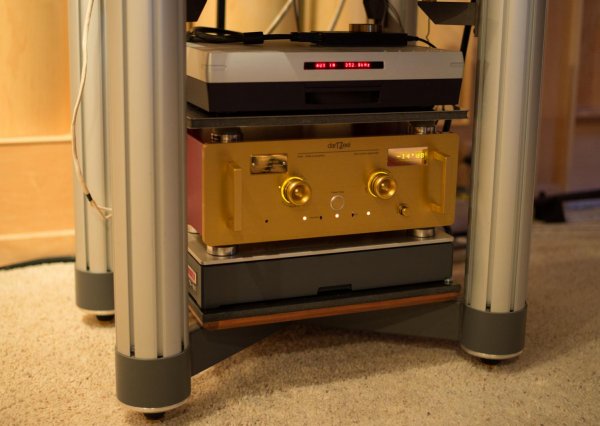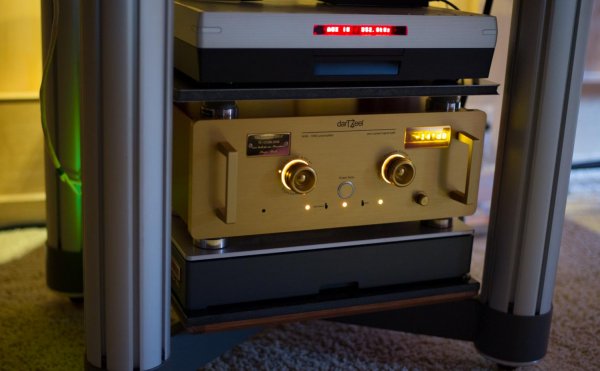I currently use a Naim Superline with a Naim SuperCap2 power supply. I dare say that it is the best solid state MC phono amp I have ever heard. Very transparent, lifelike dynamics, and totally steps out of the way (i.e. minimal coloration), to allow me to hear details via my Koetsu Jade I haven't heard before, even with my Shindo Masseto preamp/phono, my Einstein Turntable's Choice phono, or my Modwright SWP 9.0SE phono. Very impressive.
Best phono stage?
- Thread starter awsmone
- Start date
You are using an out of date browser. It may not display this or other websites correctly.
You should upgrade or use an alternative browser.
You should upgrade or use an alternative browser.
Mike,
What's the rack you're using? And that platform below the 18NS?
thanks,
alexandre
the rack is the Adona GTX-4.
http://www.adonacorporation.com/zerogxt.html
the Adona is a modestly priced 'grounded' rack that works great with decoupling footers or other isolation. previously i used the Grand Prix Audio Monaco decoupling rack system, which was very good. but i found using a grounded rack with mass combined with active isolation was better.
i had the legs on the Adona cut to the length i wanted, and did end up removing one shelf when i combined the dart pre and the Playback Designs both stacked on the Herzan TS-150 active isolation platform. the legs on the Adona can be filled with lead shot if your application needs more mass.
http://www.herzan.com/products/active-vibration-control/ts-series.html
i also use another Herzan, the TS-140, underneath my NVS tt.
there is nothing like true active isolation for optimal performance. there are threads here on WBF about this product.
with my MM7 bass towers my system needs this type product to eliminate feedback. of course, any system gets advantages from lower resonance, but ultra dynamic systems get the most benefit.
The Lemo connectors ( or XLR ) are the price to pay for running a balanced phonostage but other Legato owners has made a convertion box that can be used when experimenting with other tonearms.
Just a FWIW:
Nearly all phono cartridges are a balanced source. The usual balanced connection is the XLR connector.
If this is set up correctly there is no ground wire like you see in a single ended connection. The ground is pin 1 of the XLR.
Also, the reason for doing this is that if a LOMC phono cartridge is used as the source, the cartridge and cable form a low impedance balanced line system. The advantage of this is cable immunity- no more having to audition cables to find the right one. IOW they will all sound similar unless the cable is incorrectly wired (which will likely result in a hum).
A further note- stand-alone phono sections have to drive an interconnect cable. Because of the resulting connectivity issues some manufacturers prefer to have the phono section in the same box as the line section. This eliminates the effects of the connectors and results in greater transparency if execution is done properly.
Just a FWIW:
Nearly all phono cartridges are a balanced source. The usual balanced connection is the XLR connector.
If this is set up correctly there is no ground wire like you see in a single ended connection. The ground is pin 1 of the XLR.
Also, the reason for doing this is that if a LOMC phono cartridge is used as the source, the cartridge and cable form a low impedance balanced line system. The advantage of this is cable immunity- no more having to audition cables to find the right one. IOW they will all sound similar unless the cable is incorrectly wired (which will likely result in a hum).
A further note- stand-alone phono sections have to drive an interconnect cable. Because of the resulting connectivity issues some manufacturers prefer to have the phono section in the same box as the line section. This eliminates the effects of the connectors and results in greater transparency if execution is done properly.
Certainly more convenient not worrying about multiple ground wires on a single ground post in some cases. I have not heard any definitive statement that one sounds better than the other in practice however.
On the Balanced verses single ended I emailed or talked with a few of the better builders most said they had tried balanced but single ended sounded better. That said of the few I tried I went with the balanced as it sounded best in my system to me.
The down side of xlr phono input....not many offerings from the various top tier manufactures. My system is xlr save for phono input...I would have loved if my stage was xlr input.
Burmester and I think boulder not sure what else
That's about it. I have had deep thoughts regarding the Boulder. I love my tube Allnic. It takes the right rolled rectifier tube to get the best out of it. My Pass XP-25 sits as backup..literally unplugged from the system.
Burmester and I think boulder not sure what else
The ASR Basis Exclusiv is a balanced design and XLR is the preferred input.
^^ And Atma-Sphere. We offered the balanced input on our preamps in 1989.
It all depends on implementation. Balanced line operation is poorly understood by many high end audio manufacturers. There are certain standards that should be followed; if not the results will fall short of what is possible.
The balanced line system was devised to eliminate cable artifact and to reduce noise issues. It is why the Golden Age of stereo occurred in the late 1950s- because you could hang microphones over the orchestra and run the cables 150-200 feet without degradation. This is why older stereo LPs still sound good today... And the same benefit derives in the home when balanced line is implemented. However as I mentioned, the equipment has to be designed properly or the benefits will not be guaranteed.
For example, in a balanced system the ground is ignored- there is no signal current through the ground. This is rarely seen in high end audio equipment, but its easy to set up.
The reason a single-ended phono system has the weird grounding wire that no other single-ended source seems to need is its actually a balanced source that is being run single ended. You have to do something with the ground as single-ended and balanced connections are incompatible.
Certainly more convenient not worrying about multiple ground wires on a single ground post in some cases. I have not heard any definitive statement that one sounds better than the other in practice however.
It all depends on implementation. Balanced line operation is poorly understood by many high end audio manufacturers. There are certain standards that should be followed; if not the results will fall short of what is possible.
On the Balanced verses single ended I emailed or talked with a few of the better builders most said they had tried balanced but single ended sounded better. That said of the few I tried I went with the balanced as it sounded best in my system to me.
The balanced line system was devised to eliminate cable artifact and to reduce noise issues. It is why the Golden Age of stereo occurred in the late 1950s- because you could hang microphones over the orchestra and run the cables 150-200 feet without degradation. This is why older stereo LPs still sound good today... And the same benefit derives in the home when balanced line is implemented. However as I mentioned, the equipment has to be designed properly or the benefits will not be guaranteed.
For example, in a balanced system the ground is ignored- there is no signal current through the ground. This is rarely seen in high end audio equipment, but its easy to set up.
The reason a single-ended phono system has the weird grounding wire that no other single-ended source seems to need is its actually a balanced source that is being run single ended. You have to do something with the ground as single-ended and balanced connections are incompatible.
garylkoh
WBF Technical Expert (Speakers & Audio Equipment)
I did not check out Boulder when I was shopping a bit deeper water than I fish in. I will tell you in Canada the Burmester importer was willing to ship a Phono a preamp and amp to my dealer I bought the phono after trying it out a lest one other was bought off that demo. A third guy is trying to sell enough body parts to get one. I had it for 2 weeks in my home I do not know if other high end Companies would do that for you. It was a, well this is not going back which it did as I got a new unit with 2 MC inputs and a analog to digital convertor which I have not used yet.
I think with your level of commitment Boulder or some one else would demo one in your home. Good luck and happy hunting
If you are a well qualified customer, Burmester will do that in the US too. There were a couple of WBF members who asked me to help organize a Burmester demo, and an in-home demo was quite easily arranged.
The down side of xlr phono input....not many offerings from the various top tier manufactures. My system is xlr save for phono input...I would have loved if my stage was xlr input.
The Doshi can be had in either config.
The Doshi can be had in either config.
I'm sure. I didn't want to convey I am in the market for a new phono stage. I am immensely happy with the Allnic now that the rectifiers have been dialed in. I rarely use the head amp with it now and prefer the transformer input. When I used stock rectifiers I didn't feel that way. My favorite is a 1953 Jan RCA 5U4GB followed closely by 1967 Mullard GZ37's.
I'm sure. I didn't want to convey I am in the market for a new phono stage. I am immensely happy with the Allnic now that the rectifiers have been dialed in. I rarely use the head amp with it now and prefer the transformer input. When I used stock rectifiers I didn't feel that way. My favorite is a 1953 Jan RCA 5U4GB followed closely by 1967 Mullard GZ37's.
5u4GB and not 5u4G? Interesting. Did you compare these two tubes by any chance in your unit and what were the differences?
5u4GB and not 5u4G? Interesting. Did you compare these two tubes by any chance in your unit and what were the differences?
I just checked them..They are 5U4G's..not GB's. They both have great frequency extension throughout the range. The GZ37 bass is a bit softer/less defined than the 5U4G.
I just checked them..They are 5U4G's..not GB's. They both have great frequency extension throughout the range. The GZ37 bass is a bit softer/less defined than the 5U4G.
Ok I ended up with the RCA too. I really didn't like the GZ 37 that was included.
Similar threads
- Replies
- 5
- Views
- 841
- Replies
- 55
- Views
- 5K
- Replies
- 14
- Views
- 2K
- Replies
- 11
- Views
- 2K
| Steve Williams Site Founder | Site Owner | Administrator | Ron Resnick Site Owner | Administrator | Julian (The Fixer) Website Build | Marketing Managersing |









